ARE NIGHT SHIFTS

A study was conducted in Australia on truck drivers comparing single drivers and two-up drivers. Two-up drivers reported higher levels of fatigue and tended to show poorer levels of performance

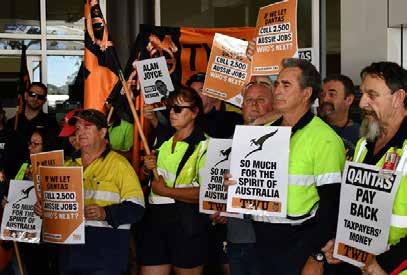






A study was conducted in Australia on truck drivers comparing single drivers and two-up drivers. Two-up drivers reported higher levels of fatigue and tended to show poorer levels of performance






At the TWU, we are relentless in the pursuit of building and exercising worker power, guided by clear, strong principles. We are committed to earning and keeping our members’ trust and bargaining collectively. We aim to hold corporations to account, empowering the workforce with a strong and powerful voice.
The TWU has a number of Enterprise Agreements in a myriad of transport companies. If you work for a company that has an EA with the TWU, you, along with all transport workers benefit from the years of struggle and collective action of union members before you.

And set the standard for transport workers into the future.
TWU Members also benefit from a range of services available only to members
Legal Services
Wage increases and improved conditions through collective bargaining
Enforcement of your agreement and workplace rights
Representation for incidents or disciplinaries
Job Security and protection
$5,000 Funeral benefits
Free Wills
Extraordinary Driver’s License
Income Protection and Group Accident and Sickness cover
Collective purchasing power of UnionShopper to provide members with discounts on a range of restaurants, gift cards, white goods and more
You should be a member of your union, the TWU if you enjoy these benefits like:
Annual Leave
Maternity Leave
Long Service Leave
Sick days
Leave loading
Penalty rates
Superannuation
Health and safety and workers’ compensation
Allowances (meal allowances, shift allowances)
Rest breaks
Unfair dismissal protection
Becoming a member of the TWU ensures you can maintain these rights into the future.


Whilst most of us drivers are pottering around up and down the highways and byways of Western Australia, unknown to most of us, is there is a large autonomous road train testing facility at Meridian Park, Neerabup just north of Perth.
Autonomous vehicles – also known as driverless vehicles are seen to be the future of heavy haulage and have been a key area of transformation in the mining and resources sector over the past decade.
It is an area that although we don’t hear much about; is expanding in leaps and bounds.
Many of the mining companies have been using this technology for years and are taking it bigger and bigger.
FMG has a fleet of driverless utes at its Christmas Creek mine site that are primarily used to ferry parts and equipment out to maintenance workers on site. You can see the practicalities and cost savings on labour as the workers don’t have to stop working on a job to go and get parts.
Rio Tinto has had an autonomous heavy haul rail system since July 2018. Consisting of three locomotives, it transports iron ore over 280 kilometres from Tom Price to Cape Lambert, All of this is monitored
remotely by operators in Perth and was the world’s first autonomous, long distance, heavy haul rail network.
The latest and potentially biggest player in the market is Mineral Resources (MinRes) who have been trialling this technology since 2021.
MinRes plan on using these driverless vehicles in a platoon formation. Four triple road trains will travel together with only the first prime mover requiring a driver.
Using only private roads the plans is to transport iron ore from the Ashburton Hub Iron Ore Project to the port. MinRes believe as well as cost savings in driver’s wages it is a much safer mode of transporting the iron ore including mitigating safety risks due to driver fatigue and inattention.
Most of us would have no idea how far this technology has advanced. Around 40km north of Perth at Neerabup, the State Government in conjunction with a number of private companies have set up the AARP – the Australian Automation and Robotics Precinct.
At 51 hectares, it is both the largest test site in Australia and also one of the biggest and most innovative test sites in the worldand it is in our backyard.
The site has been made available by DevelopmentWA, and has been operated by CORE Innovation Hub since August 2022.
It deals with all things robotic, automation and remote operations. The site houses a small scale replica of an operational mine as well as a closed fully asphalted circuit for testing and demonstrating autonomous vehicles. It also contains 30m wide dirt haul roads with loading and unloading facilities for testing of heavy haulage vehicles.
A number of both Australian (yay) and US based robotics giants are collaborating on projects that will see a massive shift in the way that the mining industry in particular will operate.
US-based robotics firm Autonomous Solutions, Inc. (ASI Mining) is one such entity using Meridian Park industrial zone at Neerabup. They have leading capability in OEM-agnostic vehicle automation systems and are deploying their Mobius autonomous haulage system (AHS) solution, together with their deployment partner global mining technology leader Epiroc to the Roy Hill mine in the Pilbara. They will be retrofitting the miner’s complete haul truck fleet of 96 trucks.
ASI Mining will use the AARP to further develop and grow purpose-built advanced robotic automated systems and the team
will also operate key functions from Neerabup, including global Autonomous Haulage System (AHS) oversight and deployment support, global technology support and AHS product management.
At the moment all the operations outside of the testing at Meridian Park are conducted on private land but it is only a matter of time before driverless vehicles become the norm on our suburban roads.
I don’t know if I would be totally happy with that, there is little enough contact and camaraderie on the road as it is and the thought of no quick chats or waves to other drivers would make this world a lonelier place.
I guess the big question is – will these driverless vehicles reduce the accident rate and will they be able to merge?
On Wednesday 4th December from 9.30am to 12pm the Global Robotics and Automation Technology Showcase entitled ‘West Tech Fest 2024’ will take place at The Australian Automation and Robotics Precinct in Neerabup.
The morning will feature Innovator Spotlights, an industry panel – connecting local and global ecosystems and an indoor and outdoor technology showcase.
There will be demonstrations from RCT Global, Switch Technologies, Australian Flow Batteries, Maclean Engineering, UX
Machines and RaptorTech.
This will be the first event of its kindcasting a spotlight on leading innovators and technology companies. International delegates are expected to descend on Perth for the event and the panel partners include Curtin University and Invest and Trade Western Australia.
Formalities will be hosted in the new state-of-the-art AARP Headquarters, including a 'Meet the Innovator' interview component, an industry panel featuring
both local and international panellists, an opportunity to witness both indoor and outdoor tech demonstrations, followed by a networking lunch to conclude.
CORE is establishing the AARP as a worldclass facility that is dynamic, collaborative, accessible and global and they guarantee it will be a morning of inspiration and innovation. For more information visit https://events. humanitix.com/global-robotics-innovationshowcase-west-tech-fest-satelliteevent?hxchl=mkt-sch

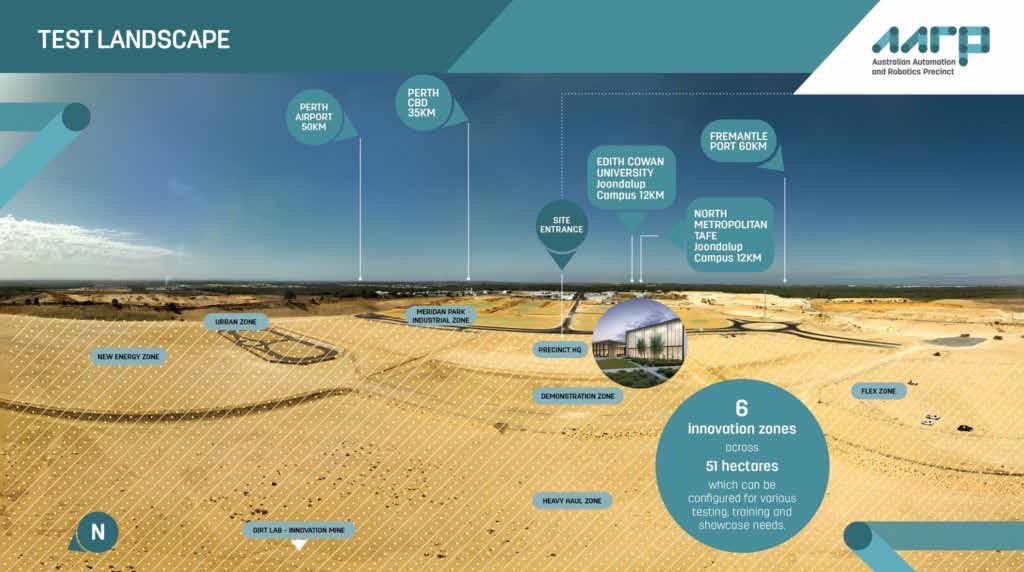
Angry Chicken Publishing Pty Ltd
Telephone 0430 153 273
www.angrychicken.com.au
ABN: 35 486 530 095
PUBLISHER / COMMISSIONING EDITOR
Karen-Maree’ Kaye
T: 0430 153 273
Email: karen@angrychicken.com.au
WRITERS
Karen-Maree’ Kaye, Russell McKinnon
CONTRIBUTORS
Jan Cooper, Cam Dumesny, Cliff Graham, Carol Messenger, Ray Pratt , Lara Jensen
ADVERTISING ENQUIRIES
Angry Chicken Head Office
T: 0430 153 273
E: karen@angrychicken.com.au
DESIGN / PREPRESS
Cally Browning | Bare Creative
ACCOUNTS
T: 0430 153 273
E: accounts@angrychicken.com.au
PRINTER
Daniels Printing Craftsmen
SUBSCRIPTIONS
Subscriptions available directly from the Publisher.
T: 0430 153 273
E: karen@angrychicken.com.au
Australia: 1 year $130 (inc GST)
Overseas subscribers: Airmail postage will be added to subscription rate.
Editorial Submissions: The Publisher welcomes editorial submissions. Once received they will become the property of the Publisher who reserves the right to edit the or adjust the content to fit with the format of our publication.
West Australian Transport Magazine (WATM) is published by Angry Chicken Publishing Pty Ltd
ABN: 35 486 530 095 All rights reserved. No part of this publication may be reproduced, adapted or transmitted in any form by any process (graphic, electronic, mechanical or storage and retrieval system) or sold, resold or otherwise exploited for any purpose without consent of the Publisher.
The publisher, contributors, editors and consultants disclaim any and all liability and responsibility to any person or party, be they a purchaser, reader, advertiser or consumer of this publication in regards to consequences and outcomes of anything done or omitted, or being in reliance whether partly or solely on the contents of this publication. No person, organization or party should rely on or on any way act upon any part of the contents of this magazine without first obtaining the advice of a fully qualified person. The Publisher shall have no responsibility for any action or omission by contributor, consultant, editor or related party for content within WATM. The opinions and content within WATM does not necessarily reflect those of the Publisher, editor or their agents. No responsibility is accepted for damage or loss of material supplied to the publisher.

ince I have been involved in the Western Australian transport industry, which is quite a few decades now - the times I have seen the most favourable incidences of support and help for the transport industry have been when you are united.
From the highly successful truck expo’s we used to have, the truck racing that so many of you embraced and the important everyday things such as safety, roads and legislation that has hindered your ability to earn an honest income and put you at risk during your job.
When you have a ‘loud’ united voice it is proven that your outcomes are more successful and history has shown us that your grievances are best given to the government bodies by industry bodies that have the membership behind them to be listened to.
The recent overturning of the new signage on road trains is one such example.
Strong voices to the powers to be from the LRTAWA, Western Roads Federation and the TWU and you were listened to.
Maybe some of you will disagree with me, but over the years I have seen Main Roads and the state government, regardless of which political party is at the helm listen and take action where common sense is irrefutable. If this were not the case Western Australia would be part of the National Heavy Vehicle Regulator as one example.
An investment in membership to these bodies is an investment in your security and future.
I wish you all a merry Christmas and a safe holiday season – which I hope you get the chance to have a break and recharge.
Best,







Our digital editions (11 per year) are available at ‘no cost’ and to subscribe please email karen@angrychicken.com.au You will receive a monthly email from us and be given a link to a high quality Flip Book that you can download and access any links within the publication.
We do not make any profit on our subscriptions. Due to the rising costs of postage and producing the magazine we charge only ‘what it costs us’ to print and post your publication to you.
To receive the hard copies, please email karen@angrychicken.com.au with the following details and you will receive an invoice with EFT details:
Visit www.isubscribe.com.au/wa-transport-magazine-subscription.cfm
Note, this option costs $140 (one year) and the price includes ISUBSCRIBE fees on top of $130 base cost (printing and postage only). Thank you for your understanding and support of an independent publisher who has been producing the WA Transport Magazine for 30 years




The second annual Perth Camp Quality Convoy for Kids was recently held, raising money and awareness for children with cancer with help from Main Roads WA.
On the morning of 13 October, the convoy departed Perth Hockey Stadium at Curtin University and travelled 53 kms around Perth on a set route encompassing Leach, Tonkin and Reid Highways, the Mitchell Freeway to Manning Road, before returning to Perth Hockey Stadium for more fun and activities for all.
In 2023 the organisers raised an impressive total of $191,239 with 135 trucks travelling in the convoy. That was surpassed this year with over $410,000 raised and 180 vehicles participating.
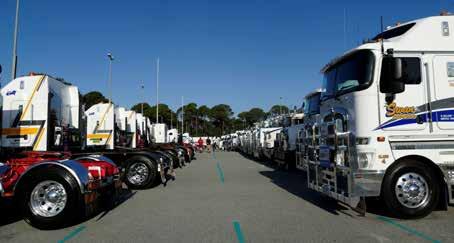

Main Roads led the convoy. Heavy Vehicle Services (HVS) Senior Traffic Escort Wardens Matt Harston and Damian Grant escorted the trucks safely through Perth, which helped to ensure a safe, enjoyable and highly visible event for all participants without incident.
The Road Network Operations Centre (RNOC) played a pivotal role in the
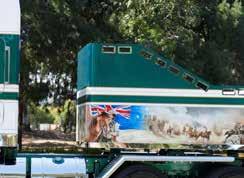
approval of the Traffic Management Plan. They suggested preferred routes, identified potential issues, and provided guidance on the requirements for the day. On the day of the event RNOC managed the traffic control signals, ensuring smooth and safe passage for the convoy.
Congratulations again to the organisers of the event on a terrific outcome.
As we head closer and closer to the end of the year, it’s timely to remind industry of the upcoming Christmas and New Year curfew periods.
The Christmas and New Year Curfews are published in the Single Trip OSOM Vehicle Standard Operating Conditions and the Class 1 RAV Oversize Period Permit Operating Conditions. These can be found at the following links.
www.mainroads.wa.gov.au/4a5efc/ globalassets/heavy-vehicles/getting-apermit/osom/single-trip-osom-vehiclestandard-operating-conditions-hvs.pdf www.mainroads.wa.gov.au/49f101/ globalassets/heavy-vehicles/getting-apermit/osom/class-1-rav-oversize-periodpermit-operating-conditions.pdf
The curfews are as follows:
1) RAVs exceeding 2.7 metres in width and/ or 30 metres in length must not travel on Forrest Highway and Lakelands Lake Clifton Road (this includes the

Mandurah and Dawesville Bypasses), between the intersections of Pinjarra Road and Peppermint Grove Road, during the period from sunset on 18th December until sunrise on 4th January.
2) AVs exceeding 4.5 metres in width and/ or 30 metres in length must not travel on any of the following roads during the periods from sunset on 23rd December





and
until sunrise on 27th December, and from sunset on 30th December until sunrise on 4th January:
(a) Albany Highway (Bedfordale Road Train Assembly Area, to Albany);
(b) Brand Highway;
(c) Eyre Highway; (d) Great Eastern Highway; (e) South Western Highway (Armadale to Bunbury);
(f) Great Northern Highway (Roe Highway to Mt Magnet).
3) RAVs exceeding 5.5 metres in width and/or 40 metres in length, must not travel on any road in Western Australia during the period from sunset on 18th December until sunrise on 4th January.
Operators are to ensure they plan their movements with sufficient time margins to accommodate any unforeseen delays, as Traffic Escort Services will not allow Oversize vehicles to proceed beyond this curfew time.




From major truck workshops, heavy haulage, cranes, the mining industry and more… our team of knowledgeable and qualified technicians share over 100 years combined experience and focus on delivering prompt service alongside the supply of top name brakes and clutchesthroughout Australia and Asia.
With over 20 years in the industry we have a well-earned reputation for the development, manufacture and supply of quality standard and customised designs to suit a wide range of applications.
For the best advice and friendly service contact us today.
+61 8 9353 4411 ■ sales@knightbrakeandclutch.com.au knightbrakeandclutch.com.au

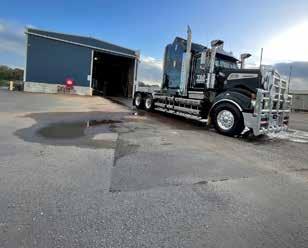






The State Government will invest $273 million to progress Westport with the investment supporting completion of designs, securing approvals, resolving risks and uncertainties, land acquisition and refining costs and construction strategies ahead of final decisions and procurement of capital works contracts.
This announcement coincides with release of the Westport Business Case Summary, which recommends a one-off transition of container trade to Kwinana by the late 2030s.
The Westport business case has been finalised, showing significant risk to the WA economy from future constraints on container trade if Westport is not built in time.
The business case found inaction to address constraints on trade could cost the WA’s economy $244 billion over coming decades – an average of $5 billion per year.
Under a moderate growth scenario, Fremantle Port is expected to reach its
capacity of 1.4 million containers per year by 2040, or as early as the mid-2030s if higher volumes of trade eventuate, with the surrounding road and rail network become significantly constrained – meaning a new port needs to be built by the late 2030s, to enable a smooth transition.
If no action is taken and trade exceeds Fremantle Port's capacity, containers bound for WA will need to be offloaded at east coast ports and transported back by road and rail.
The business case also confirmed that the option to extend the life of Fremantle Port would still require Westport to be built less than 10 years later, costing WA taxpayers an extra $2.2 billion.
On the back of strong population growth, container trade through Fremantle Port grew by nearly six per cent last financial year, representing an increase of nearly 50,000 containers compared to the year before.
WA’s population is expected to grow to 3.6 million people by 2036, which will fuel further growth in demand for container trade.
About 92km of Marble Bar Road will be upgraded to a twolane sealed road including better connections to a number of mine sites serviced by the road.
An eight-kilometre deviation around Nullagine will also be constructed, improving road safety and reducing noise through the town.
The project will be delivered in seven stages, with the first 15-kilometre section near Roy Hill now underway, and work on a further 23km of road expected to commence before the end of 2024.
The upgrades will enable safer travel for all road users, as well as heavy vehicle operators carting ore from a number of mines in the area.
Access for local Aboriginal communities and medical and other services will also be improved - with the new road expected to reduce the need for closures due to flooding in the wet season.
The upgrade is being funded and delivered by Atlas Iron with the State Government committing $60 million towards the project.
The upgrades are expected to be completed by late 2025.
The business case estimated Government investment of $7.2 billion will be required to deliver the new container port. Final budgets will be determined through procurement and capital works contracts.
The business case recommends moving container trade from Fremantle to Kwinana by the late 2030s to ensure economic impacts on the State are minimised.
Several major enabling road and rail projects such as widening the Kwinana Freeway and upgrades to Anketell Road will also be required, noting these projects will support broader outcomes including addressing existing congestion bottlenecks, supporting further development of the Western Trade Coast and enabling a major expansion of our defence industry.
The Federal Government has underscored Westport as a nationally critical project, having committed $33.5 million towards the next phase of planning, with additional funding to be sought as the program progresses towards construction.

Acollective sigh of relief could be heard throughout the Western Australian transport industry with the announcement from Main Roads that operators could choose the best signage for their specific vehicle length and configuration.
Main Roads announced that following the Heavy Vehicle Road Signage Reference Group (HVRSRG) meeting on 18 October 2024, operators now have the option to use the new RAV warning signs.
In response to concerns raised by the WA road transport industry regarding new Restricted Access Vehicle (RAV) warning signs requirements planned to come into effect on 1 January 2025, the Heavy Vehicle Road Signage Reference Group (HVRSRG) was formed.
The HVRSRG was chaired by Meredith Hammat, the Parliamentary Secretary to the Deputy Premier and the group met on 18 October 2024.
The HVRSRG included eight representatives from different areas of the

transport industry, including organisations such as the Western Roads Federation, WA Livestock and Rural Transport Association, the Transport Workers Union (TWU), and various transport companies dealing with general freight, dangerous goods and fuel.
As an outcome of the 18 October meeting, it was determined:
1. No Mandatory New Signs: Transport operators will not be required to replace the current ‘Long Vehicle’ and ‘Road Train’ signs with the new RAV warning signs.
2 Sign Options for Long Vehicles: For vehicles longer than 27.5 meters, operators can choose between:
1. The existing ‘Long Vehicle’ and ‘Road Train’ signs, or
2. New graphic signs that show the length of the vehicle (27.5m, 36.5m, or 53.5m).
The new RAV warning signs are optional but offer several benefits, including providing more information to other road users, helping them decide if it is safe to overtake the road train or long vehicle. The signs also educate drivers about the length of road trains using clear images and car graphics for comparison.
Operators can use the new signs instead of, or in addition to, the traditional ‘Road Train’ or ‘Long Vehicle’ signs. This flexibility allows operators to choose the best signage for their specific vehicle length and configuration.
The finest bodies in the industry stand together for mental health
Southwest Victorian truck drivers stripped down to their underwear to promote the 2025 Aussie Truck Driver Calendar of which all profits go to the Let’s Talk Foundation with the aim of breaking down the stigma attached around mental health.
It is said that you will see some of the finest bodies the transport industry has to offer in the 2025 calendar… Just normal everyday people who go through life’s challenges with many of the models experiencing tough times in different ways; whether it is personally, a friend or family member and they hope that their bravery in stepping outside of their comfort zone inspires other men to reach out for help if they are struggling mentally.
The Let’s Talk Foundation is a preventative, not-for-profit mental health organisation breaking stigma, educating, and raising community competency around mental health and ill-health. Based in South West Victoria, the Foundation began in 2016 with a suicide prevention focus after two bereaved parents had lost their 21 year old son to suicide.
Calendars can be purchased at www.facebook.com/profile. php?id=100070165924108
Over to you

recently spent a few days at a friend’s place at Meckering. His property and house is next to Great Eastern Highway. Every time I go there I am constantly amazed at the amount of truck traffic that goes past his gate.
It makes you aware of how huge the freight task is in this great country of ours. Even after midnight, there is the constant noise of heavy trucks going about their work.
While I’m trying to sleep I’m thinking about how these large trucks and their drivers are stepping up and keeping the freight moving. Most of the trucks have two drivers as they drive nonstop from Perth to the Eastern States and back again.
For those who don’t understand, twoup driving is when we have two drivers in the same truck. One person drives while the other person tries to get some sleep. The trucks are equipped with a sleeping compartment behind the driver with a comfortable bed. I say ‘try’ to sleep as it is exceedingly difficult when the truck is bouncing down the highway - travelling at one hundred kilometres per hour.
I have done it for many years and it does take its toll on a person’s health and lifestyle. At the end of each trip you feel extremely tired and I get grumpy – a feeling much like being jet lagged.
When this scenario is repeated every week and for years on end I found there is an obvious decline in your health. You ask yourself the question… Are night
shifts killing me?
The sad reality is that the country expects and relies on trucks to deliver freight quickly, efficiently and cheaply to keep customers happy. Working night shift is not limited to just truck driving as we have essential services like doctors, nurses, police and a myriad of other industries that rely on people working through the night. It is the way we do business and it’s difficult to navigate around the problems associated with working at night.
A study was conducted in Australia on truck drivers comparing single drivers and two-up drivers. Two-up drivers reported
Two-up drivers reported higher levels of fatigue and tended to show poorer levels of performance
higher levels of fatigue and tended to show poorer levels of performance.
There is no substitute for getting a good night’s sleep with the truck stopped.
Trying to work at night disrupts our circadian rhythms. Humans are made to work better in daylight hours and sleep at night and trying to change this rhythm has a terrible effect on our health.
Continue to work night shift and we can expect to have reduced life expectancy, poor sleep, weight gain, diabetes and depression. These are just the physical symptoms.
The psychological effects also come into play with poor social life, the risk of relationship breakdowns and difficulty having a normal family life.
Shift work can be deadly especially for truck drivers who are struggling with fatigue. I’m sure that companies and freight forwarders could minimise a lot of night driving with a bit better management.
Many times when I was battling fatigue during the night I would think that a lot of the freight I carried did not need to go as express freight. Sure, many times carting for the oil and gas industry we had deadlines to meet to keep industry working 24/7 but many a time the freight would be just stored in a warehouse for future use.
There is an increasing amount of work done on making workplaces safer but anything involving trucks seems to be put in the too hard basket. We do drive long hours and fatigue is a major problem.
We do share the roads with the general population and we as experienced drivers are expected that we do our work safely and we expect to come home safely but we could do with better support in making our work easier.
Let me sleep on that. Keep it safe, Ray Pratt.














Victoria 13-21 Bliss Court, Derrimut VIC, 3026
Tel -(03) 9369 0000
Queensland 1/15 SeeanaPlace, Heathwood QLD, 4110
Tel -(07) 3372 2223



Western Australia 5 Freight Road, Kenwick WA, 6107
Tel -(08) 9350 6470
The new Brooking Channel Bridge in Western Australia's Kimberley Region opened to traffic on the 13th November.
The $107 million project, jointly funded by the Australian and Western Australian Governments, has seen the replacement of an ageing single-lane bridge with a much stronger dual-lane structure.
The project is the first to be delivered under the WA Government's Kimberley
bottleneck with limited survival capacity in future major flood events.
Located just outside the town of Fitzroy Crossing, the new 127-metre bridge features two lanes, allowing travel in both directions. It is capable of supporting large loads including road trains and heavy goods vehicles. A new footpath has also been constructed on the bridge to allow easier access for pedestrians.
Located just outside the town of Fitzroy Crossing, the new 127-metre bridge features two lanes, allowing travel in both directions
Resilience Program.
The project strengthens the resilience of Great Northern Highway, which was critically damaged in the flooding that followed Ex-Tropical Cyclone Ellie in late 2022 and early 2023.
While the Brooking Channel Bridge was not destroyed by the flooding event, it remained a 100-metre single-lane
The Australian Dangerous Goods Code (the Code) establishes the requirements for the transport of dangerous goods by road and rail in Australia. It sets out rules and guidelines for classifying, packaging, marking, labelling and transporting dangerous goods safely.
The National Transport Commission (NTC) has prepared a draft update to ensure the Code meets current best practices and the needs of industry and regulators.
The draft Code addresses gaps, incorporates best practices, and manages new risks to keep the transport of dangerous goods safe.
As part of the review, NTC prepared a Consultation Regulatory Impact Statement (C-RIS) to gather feedback on the draft Code and evaluate the impact of proposed changes.
You can provide your feedback using the NTC's instructions at //www.ntc. gov.au/transport-reform/ntc-projects/ comprehensive-review-australian-dangerousgoods-code
The Fitzroy Bridge Alliance, comprising Georgiou, BMD and BG&E worked closely with Main Roads to deliver the project in less than nine months, ensuring its completion prior to the onset of wet season. This followed the successful, expedited delivery of the New Fitzroy River Bridge, which opened six months ahead of schedule in December 2023.
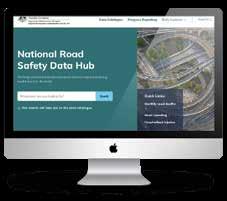
The Australian Government is increasing the road safety data collected in order to better inform responses to road trauma and the concerning increase in road deaths.
The new Road Safety Data Hub website which is now live will have data available and will be a valuable resource not only for governments, but all interested in road safety.
With the finalisation of a new Funding Agreement between States, Territories and
Data collected since the opening of Menang Drive (Albany Ring Road project) in May shows an average of around 200 trucks have been removed from the centre of Albany every single day.
The data was collected using temporary traffic monitors throughout the months of August and September with permanent counting stations to be established the next month.
The data means around 30,000 trucks destined for the Port of Albany have now used the ring road since it opened, resulting in a safer and more efficient commute for residents on local roads.
The number of trucks using the road was expected to grow significantly with the grain harvest season.
Menang Drive provides an 11-kilometre connection between Albany Highway and Princess Royal Drive, with trucks travelling to the Port of Albany now required to use this road. The new road includes three grade-separated interchanges at Albany Highway, South Coast Highway and Frenchman Bay Road.
Prior to the project, vehicles travelling to and from the port would have been using key arterial routes including Chester Pass Road, Albany Highway, and Hanrahan Road heightening the safety risk for residents and visitors to the area.
Two designated truck parking bays on Menang Drive close to Lancaster Road are also being heavily used, with demand expected to grow in the coming years.
the Commonwealth, all jurisdictions have committed to share critical data that will be used to better inform policy decisions and funding allocations under the Road Safety Program. A range of road data, including information about fatalities, hospitalisations, police enforcement and analysis of crash risk will be available.
Through the Hub, this data will be provided in a searchable catalogue. To visit go to //datahub.roadsafety.gov.au/

Agroup of cross bench members of Federal Parliament have signalled their support to unwind the fuel tax system in an effort to boost decarbonisation.
The charge is being led by Curtin MP, Kate Chaney with support from fellow teal independent, Alegra Spender and independent David Pocock.
The primary target of the initiative is the mining industry that receives significant credits for off-road diesel use. However, we in the transport industry are only too aware that big policy initiatives often have far reaching implications that were not initially contemplated.
If a Labor Government is returned at the next federal election, it is likely to be a minority government. Although the current government says it has no intention of changing the fuel tax system, minority governments sometimes surrender their principles to get a deal across the table.
Enter the minor parties and independents who will use their power to force the hand of a minority government. Let’s not forget that the legislation to phase out of live sheep exports by sea came about because of political horse trading by a minor party. In May this year the Animal Justice Party confirmed it helped secure the federal seat of Dunkley in Victoria for the Albanese Government. In return for a preference deal they demanded the end of live sheep exports. The Animal Justice Party has also said it was in negotiations with major parties for the upcoming federal election, including “making the end of live cattle export the next AJP policy and political win.
The anti-fuel tax credit group claims that FTCs are a ‘fossil fuel subsidy’ that locks in high diesel use.
In a statement that should send shivers up the spine of farmers and transporters, Ms Chaney said ‘for agriculture and logistics and trucking, which is largely under the $50 million cap, we wouldn’t
change that at the moment.’ Those three words – ‘at the moment’ indicate a longerterm objective that is not reassuring if you’re a transporter.
Respected economist Chris Richardson, in a report commissioned for Fuel Tax Credit Alliance, has pointed out the dangers in conflating taxation with climate policy, suggesting that the answer lies in having good, but separate policies in both areas.
The heavy vehicle sector doesn’t benefit greatly from credits for off-road use, which is the main target of this group of MPs, however I am cynical enough to think that mining is just the beginning, just as live sheep exports are just the beginning.
Australia has had some form of tax on petroleum products since 1901. Diesel rebates for fuel excise have been a feature of our taxation going back as far as 1957. In 2006, fuel tax credits (FTC) were introduced for fuel used in heavy vehicles and in a range of other business activities. As we all know Fuel Tax Credits are reduced by the Road User Charge which is paid per litre of on-road diesel used. It’s a simple system where excise is paid at the pump and refunded through Business Activity Statements. It’s a system that ensures users indirectly pay for the roads they use. Road funding is financed by a combination of fuel taxes and vehicle registration fees. While at some point reform will be necessary to accommodate, among other things, the loss of revenue through increased use of alternative fuels, the system in its current form is broadly successful and has incentives built in for the heavy vehicle fleet to opt for lower emission vehicles.
On the other hand, we also have climate policies with a huge amount of activity going in to meeting the target Australia has set of net zero greenhouse gas emissions by 2050.
It is important we don’t confuse raising revenue for a road network with meeting emission targets. We have to ensure we
For agriculture and logistics and trucking, which is largely under the $50 million cap, we wouldn’t change that at the moment.’ Those three words – ‘at the moment’ indicate a longer-term objective that is not reassuring if you’re a transporter
don’t introduce taxes that put a brake on productivity and impose a tax on a tax. We already have enough examples of that – take stamp duty payable on the GST on insurance premiums for example.
We might be in for a rough ride on this one over the next few years.
The recent reversal of the heavy vehicle sign initiative has shown us the benefit of good, strong industry associations. The LRTAWA, Western Roads Federation and the TWU worked closely together with a united voice and the results speak for themselves. Industry Associations are only as strong as their membership base – consider joining if you are not already a member.

by Cam Dumesny, CEO

Dorothea Mackellar beautifully described in her poem, ‘My Country', that she loved a sunburnt country, of droughts and flooding rains but she forgot to mention cyclones, bushfires and poor roads. But we forgive her because her poem lives on as a magnificent Australian epic.
But here we are again approaching another cyclone, wet and bushfire season - all of which threaten to cut our transnational truck routes at some stage.
Whilst these weather patterns are not new, the frequency at which they are occurring seems to be increasing. In just the last four years, excusing the under cooked bat virus the number of disruptions to our transnational road and rail networks
have been significant.
• 2020: Eyre Highway closed for 12 days due to bushfires
• 2022: Floods closed the Stuart Highway and both the East -West and North -South rail for over a month
• 2023: Floods washed away the bridge at Fitzroy Crossing cutting the Perth to Darwin direct route for 11 months
• 2023: Stuart Highway/Barkly Highway
- multiple extended closures for both floods then bushfires
• 2024: Bushfires cut the Eyre Highway; then floods cut the East-West rail for a month.
While the Victoria Highway was closed to flooding as was the Barkly Highway
This list is not exhaustive, there were many other incidences.
So, what is the plan?
Short answer there isn’t one.
Lots of Federal Departments and Agencies are talking about it but it’s just that – talk. The biggest source of global warming seems to be the hot air coming out of Canberra.
The concern for us, the transport industry is that road closures especially on our longdistance interstate routes can leave drivers stranded for days.
Obviously, that means if they are an Owner Driver they aren’t earning money and it’s keeping all drivers away from their family.
But it also means that in some cases how do you resupply the driver’s with basic needs? How do you get prescription medication out to them if they are stuck and isolated? Yes, we have had deal with issues like this directly, including arranging for a helicopter to drop prescription medication to a driver.
During rail outages, there is a flood of trucks coming on to the SA-WA and SA-NT routes; some of whom have never driven outside of a capital city.
That lack of driver experience is a major safety concern, with five people being killed including truck drivers during the last SAWA rail outage.
Western Roads Federation is arguing for the support of regular operators and that there needs to be safety measures implemented. We have proposed these measures to Western Australian Government.
Aproject to construct a three-legged, single-lane roundabout at the intersection of Great Northern Highway and Rutland Road in Bullsbrook has been awarded to Advanteering Civil Engineers.
The $10.5 million project will replace the existing unsignalised T-junction at this busy Bullsbrook location, significantly changing the road environment to improve safety, enhance traffic flow and reduce congestion for all road users through the area.
Currently, more than 8,000 motorists use the intersection each day, with 11 per cent of these being heavy vehicles.
The proposed roundabout has been designed to accommodate heavy vehicles,
including multi-combination vehicles up to 53.5 metres in length, as well as high wide loads.
As part of the project, new street lighting will also be installed to align with current safety standards and reduce the occurrence of crashes at night.
Between 2019 and 2023, there were 31 reported crashes at this intersection. When completed, the roundabout is predicted to reduce the number of crashes by more than 85 per cent.
This important upgrade is being funded through the State Government's Road Trauma Trust Account.
The Road Trauma Trust Account receives 100 per cent of the revenue
resulting from photographic speed and redlight camera fines.
Construction will commence in November 2024, with completion expected mid-2025.
Transport Minister Rita Saffioti said, “Safety is our top priority when it comes to improvements on our State roads, and I support any project which will upgrade the network for our heavy vehicle users.
“Service relocations for this project were completed in early-2024 to prepare this site for construction.
“I’m pleased we have now reached this important milestone, which means our State Government can continue improving WA roads, such as this vital heavy vehicle route in our north-eastern suburbs.”
We are using these freight disruptions to argue a case for better and improved Truck Rest Areas along the SA-WA, WA-NT and NT-SA routes. The logic is that these larger rest areas with facilities can double as refuge areas/concentration areas for trucks during road closures.
Allowing trucks to be concentrated in larger rest areas makes it easier to communicate with them, supply them if necessary and if required enable road trains to be turned around.
There’s also a national defence benefit, which I will explain next.
Australia’s Defence Strategy is shifting towards hardening our Northern Defence bases. Our argument is that they also need to harden our supply routes (road and rail) that connect them to our major industrial/supply areas primarily in South Eastern Australia.
Part of that hardening needs to include large rest areas which can double as convoy rest areas if/ when needed.
The article I wrote on that with Louise Bilato NT Road Transport Association for
a Defence magazine generated enough interest that I met with the defence minister recently.
Our argument also extends to earlier alerts for drivers on disruptions and financial compensation or subsidies for them, especially when the alternative route is 1000 km plus longer, plus a few other things.
Happy to hear your thoughts on how
you have been impacted during one of these circumstances.
Following the united position of Western Roads Federation, LRTAWA and the TWU to the Western Australian Government, they have changed their mind on the new truck signs that were proposed.
This proves the point that the Western Australian Transport Industry is at its strongest when we are united.
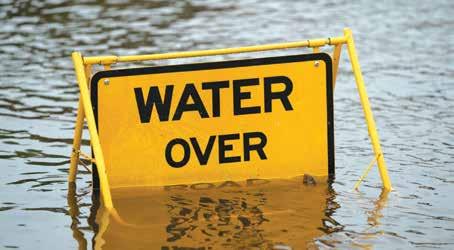
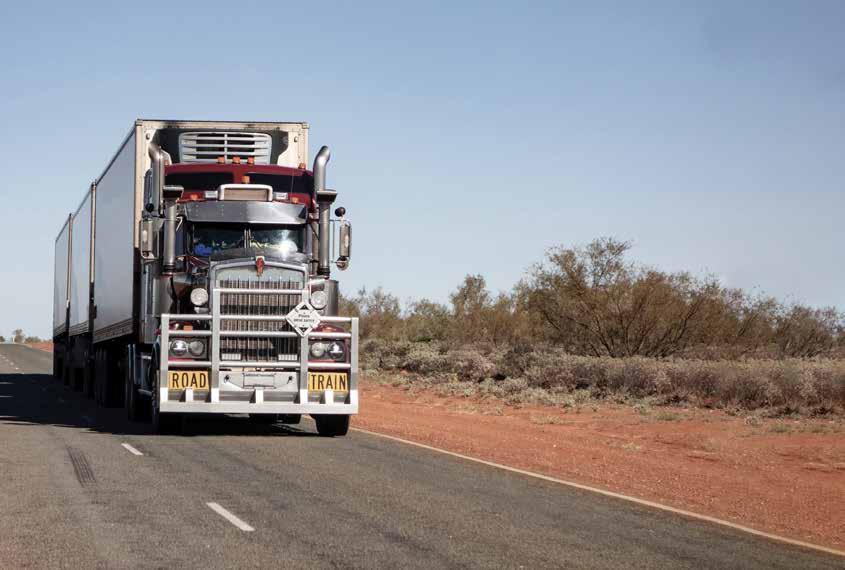


TRANSAFE WA has had an enormously successful 2024. The iNSTRUCKTA! safety truck has now attended over 120 events, with close to 40,000 participants having completed the heavy vehicle awareness VR experience since launching in January of 2023. Event bookings for iNSTRUCKTA! rose by 65% in 2024, and TRANSAFE WA are already taking bookings and locking in events for 2025.
The year has also been rewarding for TRANSAFE WA, collecting multiple awards for the iNSTRUCKTA! safety truck road transport industry safety initiative. Most significantly, TRANSAFE WA won the Rural and Remote Programs Award at the 13th Annual Australian Road Safety Awards which was held at Parliament House in Canberra. TRANSAFE WA have also been nominated for the Western Australian Community Achievement Awards and were chosen as a finalist for the Insurance Commission of Western Australia Regional Safety Award.
TRANSAFE WA recently hosted its 31st Road Transport Industry Safety Forum in WA. These highly successful forums, bring together likeminded stakeholders who

are dedicated to improving road safety outcomes. The forum presentations cover a wide range of industry related topics and updates. In 2024, forums were held in Bunbury, Perth and Kalgoorlie and,
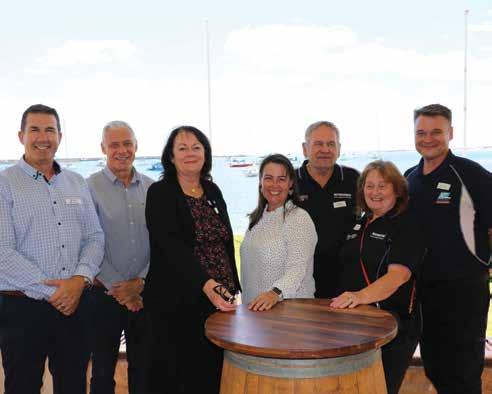
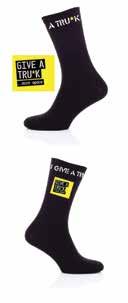

TRANSAFE WA plan to host two regional and two metropolitan forums in 2025.
The TRANSAFE WA ‘GIVE A TRU*K’ heavy vehicle awareness campaign that was launched back in 2020 to address the need to give a truck more space, more visibility, more attention and more room will soon enter its third phase. This campaign was originally adapted for radio, digital media, print media, truck-back signage and stickers. TRANSAFE WA are in the process of developing a range of wearable ‘GIVE A TRU*K promotional items so watch this space.
Finally, TRANSAFE WA held its Annual General Meeting recently and Executive Officer Rob Sharpe was pleased to confirm that the Committee of Management remains unchanged, and that the continuity of operations has been maintained with Niomi Hurley re-elected as Chairperson, Rick Post as Vice-Chair, Denis Price as Treasurer, Jan Cooper as Secretary and Ordinary Committee Members- Judith Mewhinney, Rob Hennessey, Gavin Trim, Ray Pratt, Ian Cartwright and Allan Price. Congratulations to the re-elected committee members who generously volunteer their time to deliver education and resources that support a safe, professional and sustainable road transport industry that protects its employees and the broader community.




Why is it that heavy vehicles seem to be the only link in road safety and the ones who pay for others stupidity?
Why is it that the other links in the road safety chain are completely unaccountable or clueless?
The new signage proposed for the rear of road trains in Western Australia was a clear case of this.
This new signage proposed to ‘warn’ traffic on how long the heavy vehicle is
The new access road supporting Perdaman Industries’ new $6 billion urea plant in the Burrup Strategic Industrial Area is now complete and includes a new intersection at Burrup Peninsula Road and Hearson Cove Road, with the relocation of one kilometre of Hearson Cove Road to the north-east.
The $38 million road project has delivered new dedicated left and right-turn pockets along with acceleration lanes to the north and south, and installation of new lighting.
A second intersection on Burrup Peninsula Road has also been built,
By Cliff Graham
before they over take it; but I could not for the life of me understand how it was missed that the writing on the signs is so small it can’t be read from a safe travelling distance behind the heavy vehicle.
Such signage would cost WA heavy vehicle operators millions of dollars to set up to be compliant – along with different signage for the different length combinations. All because other traffic aren’t accountable for their own actions
connecting the main access road from Burrup Peninsula Road into the urea plant.
Further improvements on Burrup Peninsula Road included a second northbound lane between Hearson Cove Road and Perdaman's main access road, with a dedicated right-turn pocket and left-turn slip lane for road users heading southbound on Burrup Peninsula Road from the urea plant.
Perdaman is a multinational group based in Western Australia and has received support for this project from the Western Australian State and Federal Government’s and the company believes the project will provide a major boost to the Western Australian economy by generating an average of around 2,000 jobs during the four-year construction phase.
On completion, the plant will provide 200 permanent jobs in Karratha and will be
and safety when sharing a road with road trains.
On my travels I see plenty of roadworks. A lot of patching on the Great Northern Highway with work being carried out on one lane however as I drive through it, I don’t see anybody working there and more than half of the temporary reduced speed signage are lying on the ground. Who is accountable for this if there is an accident?
This is disappointing to see as it
capable of providing security to Australia in respect of its needs for urea fertilisers and associated products such as diesel exhaust fluid [AdBlue].
The plant is scheduled to start production in the fourth quarter of 2025.
The Project will be one of the lowestcost suppliers of urea in the Asia-Pacific and as well as one of the largest urea producers globally.
Located 20 kilometres north-west of Karratha, the Perdaman Urea Project will convert Western Australian natural gas from Woodside’s Scarborough Gas Project into an estimated 2.3 million tonnes of urea per annum.
Transport Minister Rita Saffioti said, “Western Australia is responsible for half of our national exports, with a significant amount of resource royalties and company tax revenue flowing east as a result.
appears that after an extremely costly review from the Transport Minister of temporary signage at roadworks – nothing has changed. I then drive through Muchea to see four different car loads of transport inspectors set up to ensure heavy vehicles comply with their regulations.
Every time I drive with cattle in my trailer I consider and respect that I have live animals on board who are all doing their best to stay balanced.
Driving through Perth with them, especially at the busiest section of Tonkin Highway, Roe Highway and Kwinana Freeway cars continue to change lanes without any warning to fill the gap I am leaving for a safe stopping distance - just because they might save two seconds off their trip.
So I back off to create a safe stopping distance only to have this space taken by another impatient car driver with zero consequences for their actions. There must be something about needing to get in front of the big truck, no matter what it takes - they’ll stop and who cares about the animals?
I have invited many different people to come with me in the truck to see how traffic behaves around heavy vehicles and I only ever had one journalist come and they were shocked by what they saw.
So again I invite anyone from Police to Main Roads to the Minister for Transport to see how road designs don’t work. However I’m not expecting too many responses. These roads network are only going to get more congested with population increase.
“We’ve said repeatedly that the strength of Western Australia is critical to the national economy, and ongoing investment by our Government to help unlock these major resource projects has been essential.
“We’re proud to support developments like the Perdaman Urea Project, which will provide significant long-term benefits to our State.
“These road upgrades will also have a long-lasting impact on the Pilbara region and provide further opportunities for economic development in the area.”
Pilbara MLA Kevin Michel said, “Perdaman Industries’ new urea plant will be a critical driver of local jobs and provide a major injection into Karratha’s local economy.
“Many of the workers employed at the urea plant will be based in the Pilbara, which is important for the sustainability and longterm viability of local businesses.”
To illustrate what I mean about road designs I will share my own experience with the slip lanes from Roe Highway onto Kwinana Freeway where is reduces from two lanes to one.
Traffic is roaring up the right hand lane on the Roe Highway to get in front of the heavy vehicles that are travelling safely in the left lane. Every truck has to stop to let in unaccountable arrogant car drivers who are trying to get in front of them - causing a ridiculous bottle neck. This leads to the heavy vehicles being at a reduced speed as they try to enter lanes on the Kwinana Freeway.
I try not to hold up the flow of traffic and I try to travel in the left lane on the Kwinana Freeway only to have at least 4-5 cars roar down from the on-ramps straight out into the lane in front of me because the on ramp finishes within 100 metres. So the safe stopping distance heavy vehicles had is just gobbled up by cars.
Then, if any of them in front of you touch their brakes because they are only metres apart from each other everyone comes to a stop without any consequences or consideration of the heavy vehicles behind them - who have just had their safe stopping distance removed.
This is my own experience. While travelling approximately 90 kph south on the Kwinana Freeway past Mundijong on-ramp onto Kwinana Freeway with the 3-4 light vehicles moving from the right lane across in front of me because they wanted to go into BP Baldivis south bound along with the 5-6 cars that came from the
Mundijong on-ramp straight out onto the Freeway in front of me. I had nowhere to go as the six cars ahead of me who just came onto the Freeway decided they must be travelling too close to the vehicle in front so everyone behind had to stop.
I had nowhere to go so I was prepared to go into the Emergency Lane if I couldn’t stop. Only to find the car in front of me moved into the Emergency Lane then stopped. So then I honestly had nowhere to go. I had no drama with the car moving into the Emergency Lane if they kept driving but why stop? That actually created a more dangerous situation than if they had stayed in their own lane.
I was thinking I will be ticked off if I have to head bush because of the arrogance of road users who have no consideration nor face any consequences for their own dangerous actions.
So now I never stay in the left lane through that section of road. However a third lane that continued from Mundijong on-ramp to BP Baldivis exit would prevent a lot of unnecessary dangerous lane changes by people who don’t care of the consequences of what happens behind them.
Listening to a Police representative on the radio recently where they said road safety should be up to each individual –well that would be great if it were a reality.
Yet no other link in road safety is policed and regulated to comply with standards as much as Heavy vehicles. Every load deserves to be delivered. Every person deserves to go home. Even heavy vehicle drivers.
The project will be capable of providing security to Australia in respect of its needs for urea fertilisers and associated products such as diesel exhaust fluid [AdBlue].

The Towing Services Bill 2024 to create a safe, fair and efficient crash towing industry for Western Australians has passed State Parliament and will take immediate effect.
Spotter fees that are advertised, offered or paid to members of the community for reporting a crash are now banned with penalties up to $45,000.
New regulations will soon cap the price for the standard towing and storage of crashed light vehicles in Perth and Peel.
These regulations will also require that charges for all other crash towing and storage across the State are to be reasonable.
Increased penalties are also on the way for towing workers and towing service providers who breach the requirement of the Authority to Tow form or who behave unacceptably.
The Department of Transport will soon commence information sessions to educate industry on the new regulations and the wider reforms.
The National Transport Commission, governments and industry must develop a long term vision for our current and future priorities, ATA CEO Mathew Munro said speaking at the NTC’s Industry Forum.
“We particularly need to have a common vision on technology and data use. If we don’t have one, we are likely to end up with many different telematics devices in each vehicle, each gathering different data for different arms of government. This would be complex, inefficient and costly,” Mathew said.
There is always resistance to new technology, which we can see with electronic work diaries
“There is always resistance to new technology, which we can see with electronic work diaries. Some drivers and businesses have started to use them and won’t ever go back to paper.
“Others are concerned about the potential for enforcement surveillance, especially when our current laws don’t always allow for practical and compliant operation.
“In discussions with the NTC and other agencies, the ATA has raised a series of issues where prescriptive legal
drafting is preventing the adoption of new technologies. These include the road rules for steep descents, fatigue detection technology, steer axle mass and the spacing between tandem twin steer axles.
“We need a long term vision and fixes to the underlying laws so that safer and more productive technology can be adopted without unnecessary delay,” he said.
South West residents can complete an expanded range of transport transactions in Busselton with the new Department of Transport (DoT) centre Busselton now open.
The new one-stop-shop is located at Unit 1, 57 Cook Street, Busselton will offer over-the-counter support for on-demand transport operators.
Australia Post Busselton will continue to accept payments for driver's licence and vehicle renewals, transfer of vehicle ownership, boat licence renewals, infringements and Country Age Pension Fuel Card applications.
The new centre will be open 8.30am-4.30pm Monday to Friday.
afety upgrades to the Great Eastern Highway are continuing with a $23 million contract awarded for works in the Wheatbelt Region.
The upgrades form part of the Australian and Western Australian Government's $250 million Great Eastern Highway Upgrades, delivering improvements to various sections of the highway through the Wheatbelt and Goldfields-Esperance Regions.
Fulton Hogan received the contract to deliver three sections of road reconstructions, widenings and sealings including:
• 4.4km between Carrabin and Bodallin
• 4.6km between Nulla Nulla South Road and approximately 700m west of Liddell Road (west of Moorine Rock)
• 2.4km between Liddell Road and Granich Road (west of Moorine Rock)
The project also includes upgrades to the intersections of Great Eastern Highway with Smyth Road, Nulla Nulla North Road, Bin Road and Granich Road and the installation of new safety barriers, kerbs, signs and audible edge and wide centre line road markings.
The upgrades follow the completion of major works on the highway including:
• Widening and sealing between Stephen
Road and Noongar South Road
• Realignment through the Bodallin townsite
• Intersection upgrades at Penton Road, Ivey Road, Blyth Road, Bodallin South Road and Bodallin North Road
• Construction of an eastbound passing lane between Bodallin and Moorine Rock
• Construction of a westbound rest area between Bodallin and Moorine Rock
The works funded under the $23 million contract are expected to be completed in late 2025 with the staged upgrade program continuing along the highway until 2028.
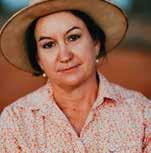
By LARA JENSEN
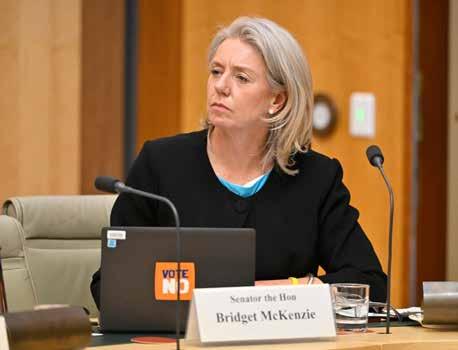
At the Senate Rural and Regional Affairs and Transport Legislation Committee in Canberra early last month Nationals Senator Bridget McKenzie conducted a line of questioning around the lack of progress specifically on train visibility standards despite our families’ advocacy efforts over the last two decades.
The Senator asked senior government bureaucrat and First Assistant Secretary (Surface Transport Emissions and Policy Division) Paula Stagg as to why the WA State Coroner Alastair Hope's recommendations for additional train visibility lighting from 2001 had still not been accepted, or acted on, or led to changes made to prevent further fatalities.
Ms Stagg predictably didn’t give a direct response and said she couldn’t comment on ‘why our predecessors may not have taken action in relation to that’ and added that she thought ‘the families are right to be frustrated that there was no action sooner’.
Frustrated – that’s the understatement of the century. We are beyond frustrated because it is beyond ridiculous that trains, the largest and heaviest of all land vehicles, aren’t required by law to be lit to a particular standard like bicycles, caravans, trucks or dinghies in 2024.
I would also like to point out to Ms
Stagg as to exactly how farcical and longstanding the reluctance by the government to insist the rail industry improves their standards has played out for.
To put our decades old historical fight for rail safety reform into context, it was in December 2003 that my co-campaigner Merrilea Broad gave a speech to the House of Representatives Standing Committee on Transport and Regional Services to raise the issue of level crossing safety, in particular train conspicuity following the death of her oldest daughter Jess Broad, my youngest brother Christian Jensen and their friend Hilary Smith who were all killed when a fully loaded grain train hit them on dark at a notorious Wheatbelt crossing.
Merrilea closed her speech with this statement:
“Our plea is to stop the “Ripple Effect” and make trains and not just the crossings more visible.
We would like to hope that the system they believed in them will not fail them.”
But the system continued to fail them. Just a year after Merrilea travelled to Canberra a report released by the House of Representatives Transport Committee recommended all locomotives should be fitted with rotating beacon lights to help make them more visible and reduce
level crossing accidents. The Australian Federal Government responded to these recommendations by stating they would not support moves to make rotating beacons compulsory, without evidence that this would be worth the costs involved. This is extraordinary considering the government would pass on any compliance costs of fitting rotating beacons to the rail industry anyway.
Staggeringly, in the last three years we have also seen the release of three national train lighting reports commissioned by the Office of the National Rail Safety Regulator (ONRSR) that have all recommended better train lighting, yet the rail industry still refuses to act, and the government still fails to legislate.
Rail operators have done nothing in the face of clear evidence that change is needed, the national rail safety regulator, Office of the National Rail Safety Regulator (ONRSR) has done nothing to ensure they act on the evidence, and Transport Ministers have not been actively engaged or taken their responsibilities seriously.
So, on that note I have written a direct appeal to WA Transport Minister Rita Saffioti for her to help our families (of rail crash victims) to prevent further senseless tragedy in the same way she has done for her own family in the newly introduced safety legislation, ‘Tom’s Law’.
While we have a national law – the Rail Safety National Law (RSNL), rail safety is a state responsibility, so each state passes individual legislation. So, the WA Government has the sovereign right to amend its legislation by adding a clause requiring rail operators to have mandatory train and rolling stock safety and visibility lighting. This is something Minister Saffioti has the power to do for our families in her capacity as WA Transport Minister.
I have asked Minister Saffioti if she will direct legislative change informed by coronial recommendations, science, and engineering, research, and common sense that all highlight the importance of improved train illumination over more than two decades and that will help achieve actual safety outcomes on our rail and road network so our loved ones too will not have died in vain.
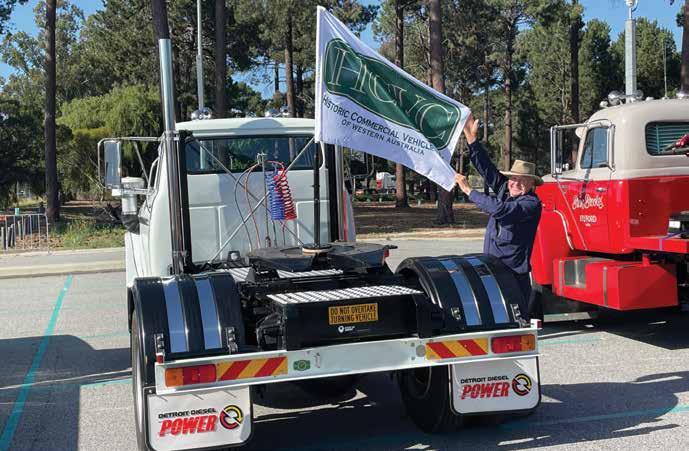

You can’t be anything but proud of the Western Australian transport industry and their unequalled support of the Camp Quality 2024 Convoy. With 180 trucks registered and another 20 or more on the waiting list in case anyone dropped out, no one will be surprised if the 2025 breaks more records.
It was encouraging to see plenty of spectators encouraging the drivers to use their air horns along the 53 kilometre loop of Perth city despite a quiet start with a noise curfew in place until 9am.

No mutterings of ‘noisy trucks’ on this day from the public who were delighted with the loudest of the horns.
Congratulations to the top fund raiser who gathered over $25K from his supporters and subsequently was the lead truck of the event, Shayne Coyne with his immaculate Kenworth.
Brian Brooks was the top fund raiser from the HCVC with $1490, well done. Overall, the 180 trucks raised over $400 000. A great event to be involved in and we hope to be back again in 2025.







By Russell McKinnon

Aformal valuation of the Cohn Street site was being sought in the prolonged procedure to get both titles secured before a possible resolution to a proposed sale.
An offer of $3.85 million was received for the Cohn Street property in August.
A lead story in the October 12 issue of One Voice under the heading “Striking wharfies’ live in a dream world?”
Once again we have a minority group – MUA – holding industry and the State to ransom.
It must be time when our Federal leaders have or develop the internal fortitude to stand up and do something about the latest irresponsible claims by a union that lives in dreamland.
Have they thought about the impact on those hard-working operators and businesses that are being affected?
The Federal Government’s Fair Work system is ludicrous.
We have a system where employees can take action (strike) that will stop a well-managed functioning major port in a capital city –namely Fremantle Ports.
What is amazing is that you cannot ask Fair Work to intervene and unfortunately this is virtually lack of care and responsibility, which allows entities like the MUA, who believe the State cannot do without them, hold the Port of Fremantle to absolute ‘ransom’.
On ABC Radio (Wednesday) the MUA Assistant Secretary ‘wanted to have the same hours as those working on the Kwinana industrial strip’.
What makes them so special?
The MUA previously agreed on a 12 percent pay rise over three years but now the MUA wants its fellow union workers to work four days and have six days off – who wouldn’t?
What about the transport operators, and how about the CBH–
Once again we have a minority group – MUA — holding industry and the State to ransom
BP-Alcoa staff, plus others, and again the question has to be raised – what makes the MUA so special?
When things start to tighten maybe it is time for the MUA to really see what happens – let a few of them lose their jobs (both their primary occupation as well as their ‘cashies’ [ie, part-time work]) and then we may have a workplace that is suitable for one and all.
Fremantle Ports has to be applauded and its Chief Executive Chris Leatt-Hayter has a difficult round of negotiations ahead, because if he gives in to the ambit claims, the MUA will be followed by other parties doing likewise, and this is not what the transport industry and others need.
History repeats itself – we all remember Chris Corrigan and the actions undertaken during the 1998 Australian waterfront dispute in which Corrigan attempted to sack the heavily unionised workforce and replace it with strikebreakers, eventually leading to reform and restructuring of dockyard labour practices.
Could this be something that lies ahead or is a sign of the future – ummm, one wonders?
WARTA’s sponsors at this stage are: TWUSuper, BP Australia, Castrol, Nexus Risk Services, NTI, BCI, NBS, Equipment Finance, Scania, CGU, Volgren, Diesel Motors Trucks, Volvo, Beaurepaires/ Goodyear and The Truck Centre.
Ian Harrower attended his last meeting as a member of the Committee of Management on September 6. His service to the industry was long and he is to be honoured with an appropriate function.
From the One Voice of October 10: “The ATA has put forward a submission on Australia's skills and workforce development needs and Productivity Agency, highlighting the driver shortages facing the industry and setting out recommendations to both the Government and industry to address this problem.
The freight task is set to double by 2020, and the rate of driver recruitment will need to increase drastically to avoid shortages. The ATA’s recommendations are intended to make the industry more attractive for groups who are not typically truck drivers, including women, younger workers and the Indigenous community.
Some of the recommendations in the report include promoting the industry to young school leavers, altering the licensing regulations and insurance to be less restrictive for young drivers, and improving the flexibility of working hours to improve the work life balance for potential drivers with family commitments.”



The Livestock and Rural Transport Association of Western Australia (Inc) is the only transport association in WA specifically representing rural transporters.
We are a strong voice for rural WA, ensuring that policy decisions support the viability and safety of rural transporters, primary industry and the communities they service.
Members of the Management Committee are hands on business people, most of whom would drive a truck weekly and travel on nearly every road in WA’s 150,000 km road network in the course of a year.
This close proximity between transporting operations and the advisory role means that representatives of the Association are at the coal face and as such are able to provide that all too rare practical hands on advice in committees, consultative forums and meetings.


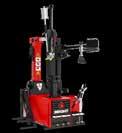








• Combining our proud histories
• Protecting members’ retirement savings
• Lower fees and strong long-term performance
• Insurance designed for dangerous occupations
